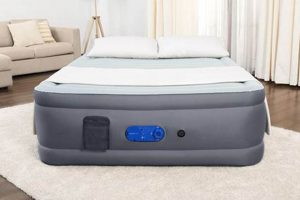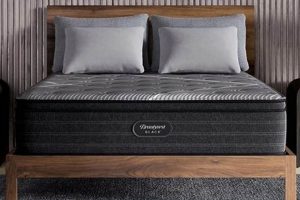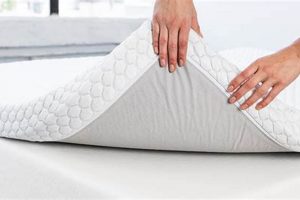The ideal sleep surface for partners with higher body weights necessitates robust construction and materials designed to withstand substantial and consistent pressure. Such a mattress must provide adequate support to prevent sagging, maintain spinal alignment, and ensure comfortable weight distribution across the sleeping surface. An example would be a hybrid mattress with a reinforced coil system and high-density foam layers.
Selecting an appropriate mattress contributes significantly to sleep quality and overall well-being. Adequate support minimizes pressure points, reduces the likelihood of pain, and promotes proper spinal alignment, all of which are crucial for restful sleep. Historically, individuals have addressed these needs through varied methods, evolving from simple straw beds to sophisticated innerspring and foam technologies.
The subsequent sections will explore key factors to consider when choosing a suitable sleep solution, including mattress type, materials, firmness levels, and crucial support features. Focus will be given to properties that ensure durability and comfort for couples seeking enhanced sleep quality.
Guidance for Selecting a Suitable Mattress
This section offers practical guidance on selecting a mattress designed to accommodate individuals with higher body weights, particularly couples. These considerations will aid in making an informed decision regarding long-term sleep quality and mattress durability.
Tip 1: Prioritize Innerspring or Hybrid Models: Mattresses incorporating innerspring systems, especially those with individually wrapped coils, provide enhanced support and motion isolation. Hybrid models, combining innerspring with foam layers, offer a balance of support and comfort, suitable for diverse sleeping preferences.
Tip 2: Opt for High-Density Foam: When considering foam mattresses or foam layers within a hybrid model, select high-density options. High-density foams resist compression and maintain their structural integrity over time, preventing premature sagging and ensuring consistent support.
Tip 3: Evaluate Edge Support: Robust edge support is essential, particularly for couples, as it maximizes the usable sleeping surface and prevents the feeling of rolling off the mattress. Reinforced edges, often found in higher-quality models, extend the mattress’s lifespan and overall comfort.
Tip 4: Consider Firmness Levels: Mattress firmness is subjective but critical. Individuals with higher body weights often benefit from firmer mattresses that provide adequate support and prevent excessive sinking. However, personal comfort preferences should also be taken into account.
Tip 5: Review Weight Capacity Specifications: Reputable mattress manufacturers specify the weight capacity of their products. Ensuring that the chosen mattress can accommodate the combined weight of both individuals is crucial for preventing premature wear and maintaining optimal performance.
Tip 6: Breathability and Cooling Features: Mattresses with enhanced breathability, such as those incorporating gel-infused foam or open-cell structures, can help regulate temperature and prevent overheating. This is especially important for a couple sharing a mattress, as body heat can contribute to discomfort.
Tip 7: Read Reviews and Seek Recommendations: Thoroughly research mattress models and brands, paying close attention to reviews from other couples with similar needs. Seeking recommendations from sleep specialists or healthcare professionals can also provide valuable insights.
Implementing these guidelines will enable the selection of a mattress that provides adequate support, comfort, and durability, promoting restful sleep and overall well-being for both partners.
The subsequent section will discuss the impact of mattress materials on overall comfort and longevity.
1. Reinforced Edge Support
Reinforced edge support is a critical design element for any mattress intended for use by couples, particularly when one or both individuals are overweight. The absence of adequate edge support leads to compression and breakdown of the mattress perimeter over time, reducing the usable sleep surface and causing a sensation of instability. The correlation is causal: heavier individuals exert greater pressure on the edges when sitting or sleeping near them, accelerating the deterioration process if the support is insufficient.
The importance of reinforced edges stems from their role in maintaining the structural integrity of the mattress. Mattresses lacking this feature often exhibit significant sagging along the edges, diminishing the overall comfort and support provided. For instance, a couple sharing a standard queen-size mattress without reinforced edges may effectively lose several inches of usable width due to edge collapse, leading to compromised sleep positions and potential discomfort. In practical terms, this means investing in a mattress with robust edge support translates directly into a longer lifespan and a more consistent sleeping experience.
In summary, reinforced edge support is not merely a desirable feature but an essential component of a suitable mattress for couples with higher body weights. It mitigates edge sagging, maximizes the sleep surface, and contributes to the overall durability of the mattress. Choosing a mattress with this feature addresses a significant challenge related to weight distribution and long-term performance, thereby aligning with the broader goal of selecting a sleep solution that promotes comfort and restful sleep.
2. High-Density Core Materials
The selection of high-density core materials in mattress construction represents a pivotal consideration when addressing the needs of couples with higher body weights. These materials form the foundational support system of the mattress, directly influencing its durability, stability, and long-term performance. Prioritizing high-density components is essential for sustaining comfort and preventing premature degradation.
- Enhanced Support and Pressure Distribution
High-density foams and innerspring systems effectively distribute weight across the mattress surface, minimizing pressure points that can lead to discomfort and disrupt sleep. For instance, a high-density memory foam core conforms to the body’s contours while providing consistent support, preventing excessive sinking and maintaining spinal alignment. This is vital for individuals with higher body weights who require ample support to avoid strain on joints and muscles.
- Improved Durability and Longevity
Materials with greater density resist compression and deformation over time, extending the lifespan of the mattress. A mattress with a low-density foam core may quickly develop indentations and
sagging, particularly under concentrated weight. In contrast, a high-density latex or polyurethane foam core maintains its structural integrity, ensuring consistent support and comfort for years, thus justifying the initial investment. - Reduced Motion Transfer
High-density materials contribute to minimizing motion transfer, a crucial factor for couples sharing a bed. The dense structure absorbs and isolates movement, preventing disturbances from one partner’s tossing and turning from affecting the other. Examples include mattresses with individually wrapped coils combined with high-density foam layers, which effectively dampen vibrations and promote undisturbed sleep.
- Temperature Regulation
While density is paramount, the specific type of high-density material also influences temperature regulation. Open-cell foams, often engineered with high density, promote airflow and dissipate heat more effectively than closed-cell alternatives. This is particularly beneficial for individuals who tend to sleep hot, as it helps maintain a comfortable sleeping temperature throughout the night.
In conclusion, the strategic use of high-density core materials in mattress design directly addresses the unique requirements of couples with higher body weights. By providing enhanced support, improving durability, minimizing motion transfer, and influencing temperature regulation, these materials are instrumental in ensuring a comfortable and restful sleep experience.
3. Effective Weight Distribution
Effective weight distribution is a core determinant in evaluating a mattress’s suitability for couples with higher body weights. The ability of a mattress to evenly distribute weight across its surface directly influences spinal alignment, pressure point relief, and overall comfort. Insufficient weight distribution leads to concentrated pressure in specific areas, causing discomfort, disrupting sleep, and potentially exacerbating existing musculoskeletal conditions. A mattress that successfully distributes weight minimizes these issues, promoting restful sleep and supporting long-term physical health.
One manifestation of effective weight distribution is observed in mattresses featuring zoned support systems. These systems incorporate varying levels of firmness in different areas of the mattress, strategically targeting specific regions of the body, such as the shoulders, hips, and lower back. By providing tailored support, zoned systems prevent excessive sinking in heavier areas and ensure proper spinal alignment. For instance, a mattress with firmer support in the lumbar region can alleviate lower back pain by maintaining the natural curvature of the spine. Conversely, a mattress lacking effective weight distribution may cause the hips to sink too deeply, leading to spinal misalignment and discomfort. The practical implication is that individuals awaken feeling stiff and achy, rather than refreshed.
In summation, the concept of effective weight distribution is inextricably linked to selecting an optimal mattress for couples with higher body weights. Mattresses that prioritize this feature contribute to improved spinal alignment, pressure relief, and overall comfort. While individual preferences regarding firmness and material composition remain relevant, the underlying principle of even weight distribution serves as a critical benchmark for evaluating the potential of a mattress to meet the specific needs of this demographic. Addressing this aspect is essential for ensuring restorative sleep and mitigating potential health concerns.
4. Durable Coil Construction
Durable coil construction is a pivotal factor in determining the suitability of a mattress for couples with higher body weights. The relationship is causal: robust coil systems provide essential support, preventing sagging and maintaining spinal alignment under substantial pressure. Inadequate coil construction results in premature mattress failure, diminished comfort, and potential musculoskeletal issues. The coils act as the primary support structure, and their durability directly correlates with the mattress’s ability to withstand consistent and concentrated weight.
The importance of durable coil construction manifests in several ways. Higher gauge steel, greater coil density, and advanced coil designs (such as individually wrapped or pocketed coils) contribute to enhanced support and motion isolation. For example, a mattress with a low coil count and thin gauge steel may quickly lose its shape and support capacity under the combined weight of two individuals, leading to discomfort and disturbed sleep. Conversely, a mattress featuring a high coil count, thick gauge steel, and individually wrapped coils offers superior support, minimizes motion transfer, and extends the mattress’s lifespan. These systems prevent partners from disturbing each other’s sleep due to movement. This difference translates to a more restful and comfortable sleeping experience over time. Furthermore, the choice of coil construction has ramifications for edge support, preventing “roll-off” sensation and maximizing the usable sleep surface.
In conclusion, durable coil construction is not merely a desirable feature but a fundamental requirement in a mattress designed for couples with higher body weights. Its influence on support, longevity, motion isolation, and edge support makes it a critical determinant of mattress quality and suitability. Choosing a mattress with robust coil construction ensures a more comfortable, supportive, and durable sleep surface, thereby addressing the unique needs of this demographic. The absence of durable coil systems is a significant risk factor for premature mattress failure and compromised sleep quality. Thus, durable coil construction is integral to the concept of “best mattress for overweight couple”.
5. Enhanced Airflow Design
Enhanced airflow design is a critical, often overlooked, component of a suitable mattress for couples where one or both partners are overweight. The correlation between body weight and body temperature is well-established; increased mass often results in greater heat retention. Mattresses lacking adequate airflow tend to trap heat, leading to discomfort, restless sleep, and potentially exacerbating existing medical conditions. The presence of enhanced airflow mitigates this issue, promoting a more comfortable and restorative sleep environment.
The incorporation of breathable materials, open-cell foam structures, and ventilation channels directly influences temperature regulation within the mattress. For example, mattresses employing gel-infused memory foam, in conjunction with strategically placed ventilation channels, facilitate heat dissipation and prevent the build-up of moisture. In contrast, mattresses composed of dense, non-breathable materials impede airflow, creating a warm and humid environment that disrupts sleep. Practically, this means a couple sharing a mattress with limited airflow may experience night sweats, discomfort, and frequent awakenings, while the same couple sleeping on a mattress with enhanced airflow would likely experience improved temperature regulation and more restful sle
ep. The selection of materials with innate breathability further contributes to this effect, with natural fibers like cotton and wool providing better ventilation compared to synthetic alternatives.
In summary, enhanced airflow design is an essential attribute of a mattress designed to meet the specific needs of couples with higher body weights. It mitigates heat retention, promotes temperature regulation, and contributes to a more comfortable sleep environment. While factors such as support and durability remain paramount, the consideration of airflow is integral to ensuring optimal sleep quality. Therefore, when evaluating mattresses, couples should prioritize models incorporating design features that actively promote ventilation and heat dissipation to achieve the desired level of comfort and restful sleep.
6. Motion Isolation Capability
Motion isolation capability is a crucial characteristic in selecting a mattress suitable for couples, particularly when disparate weights or sleep patterns are present. The ability of a mattress to minimize the transfer of movement from one side to the other directly impacts sleep quality and overall comfort. Its significance is amplified when considering the best mattress for overweight couple, where weight differentials can exacerbate motion transfer issues.
- Minimizing Sleep Disruption
A mattress with excellent motion isolation prevents disturbances caused by one partner’s movements from reaching the other. For example, if one individual frequently tosses and turns during the night or gets in and out of bed at different times, a mattress with poor motion isolation will transmit these movements, potentially waking the other partner. A real-world implication of this is reduced sleep fragmentation and improved daytime alertness. This is especially vital in the context of an overweight couple, where the potential for heavier movements and increased pressure points elevates the need for effective motion isolation.
- Material and Construction Impact
The materials and construction techniques used in a mattress significantly influence its motion isolation capabilities. Memory foam and latex mattresses, particularly those with individually wrapped coils, tend to excel in this area. These materials absorb and dampen movement, preventing it from spreading across the surface. In contrast, traditional innerspring mattresses with interconnected coils often exhibit higher levels of motion transfer. The structural design directly affects the mattresss ability to decouple movements. This is critical when discerning the best mattress for overweight couple, because the inherent supportive characteristics of the innerspring must be balanced with the dampening effects of other materials to achieve adequate motion isolation.
- Weight Differential Considerations
In couples with significant weight differences, motion isolation becomes even more critical. The heavier partner’s movements exert greater force on the mattress, potentially amplifying the transfer of motion to the lighter partner. Without adequate motion isolation, the lighter partner may experience exaggerated disturbances and reduced sleep quality. An overweight couple’s mattress selection should therefore prioritize advanced motion isolation technologies to mitigate this effect.
- Long-Term Relationship Implications
Chronic sleep deprivation due to motion transfer can contribute to relationship strain and reduced overall well-being. When both partners consistently experience disrupted sleep, it can lead to irritability, fatigue, and decreased cognitive function. Investing in a mattress with effective motion isolation is a proactive step toward promoting healthy sleep habits and maintaining a harmonious relationship. Given the importance of sleep for overall health and well-being, the capacity to minimize nocturnal disturbances is a critical element in establishing what constitutes the “best mattress for overweight couple.”
The combined effect of these facets underscores the importance of motion isolation for couples, especially when considering the “best mattress for overweight couple”. Addressing motion isolation enhances sleep quality, prevents disturbances, accommodates weight differentials, and contributes to long-term relationship well-being. It is therefore a fundamental factor in the selection process.
7. Extended Lifespan Expectation
The anticipated duration of a mattress’s usability is a critical consideration when identifying the “best mattress for overweight couple.” Given the increased stresses placed on the sleep surface, the demand for enduring performance is paramount. A mattress with a short lifespan necessitates frequent replacement, resulting in increased expense and potential disruption of sleep patterns. Therefore, the expectation of extended usability directly informs the selection process.
- Material Quality and Durability
The materials used in mattress construction significantly impact its longevity. High-density foams, robust coil systems, and reinforced edge support contribute to a mattress’s ability to withstand consistent pressure and resist sagging. For example, a mattress employing high-density latex or individually wrapped coils is likely to outlast a mattress made with low-density polyurethane foam and interconnected coils. This is paramount to identifying the “best mattress for overweight couple”, as increased body mass and pressure require durable construction to resist breakdown.
- Construction Techniques and Reinforcement
How a mattress is assembled influences its resistance to wear and tear. Reinforced seams, robust quilting patterns, and secure layering of materials contribute to overall structural integrity. An example is a hybrid mattress that combines a coil system with multiple layers of high-density foam, all securely bonded to prevent shifting and separation. Construction methods that prioritize reinforcement provide enhanced durability and are crucial in defining the “best mattress for overweight couple”, as they contribute to maintaining support and comfort over an extended period.
- Warranty and Support Policies
A comprehensive warranty from the manufacturer provides assurance regarding the mattress’s expected lifespan. Longer warranty periods often indicate greater confidence in the product’s durability. Furthermore, readily available customer support can address potential issues and extend the mattress’s usability. Warranty terms, combined with consumer reviews, are pivotal to discerning which mattress is the “best mattress for overweight couple” as they can signal the manufacturers commitment to quality and long-term performance.
- Weight Capacity and Load Distribution
The ability of a mattress to effectively distribute weight is directly related to its lifespan. Mattresses designed to accommodate higher weight limits and distribute load evenly across the surface are less prone to premature sagging and deformation. An example is a mattress with zoned support that provides targeted reinforcement in areas that bear the most weight. Consideration of weight capacity and load distribution is a determining factor in identifying the “best mattress for overweight couple,” because a mattress with inadequate specifications will
exhibit accelerated wear and reduced lifespan.
These facets demonstrate that the expectation of an extended lifespan is intricately linked with the identification of the “best mattress for overweight couple.” Material quality, construction techniques, warranty coverage, and weight capacity all contribute to a mattress’s ability to withstand the unique demands of this demographic. Emphasizing these factors ensures a valuable investment that provides lasting comfort and support.
Frequently Asked Questions
This section addresses common inquiries regarding mattress selection for couples where one or both partners have higher body weights. The intent is to provide clear, factual information to aid in making informed decisions.
Question 1: What mattress type is generally recommended for couples with higher body weights?
Innerspring and hybrid mattresses are often recommended due to their robust support systems. Individually wrapped coils and high-density foam layers contribute to both support and motion isolation.
Question 2: How important is edge support for heavier couples?
Edge support is crucial. Reinforced edges prevent sagging and maximize the usable sleep surface, particularly important when two individuals share the bed.
Question 3: Does mattress firmness matter for overweight individuals?
Firmness is subjective, but generally, firmer mattresses provide better support and prevent excessive sinking. However, personal comfort preferences should also be considered.
Question 4: What is the significance of mattress weight capacity?
Ensuring that the mattress’s weight capacity meets or exceeds the combined weight of both individuals is essential. Exceeding the weight limit can lead to premature wear and reduced support.
Question 5: How does motion isolation factor into mattress selection?
Motion isolation minimizes disturbances caused by one partner’s movements, particularly important when there is a significant weight difference or differing sleep patterns.
Question 6: What materials promote temperature regulation in a mattress?
Breathable materials such as gel-infused foam, open-cell foam, and natural fibers like cotton and wool help regulate temperature and prevent overheating.
Key takeaways include the importance of robust support, adequate edge reinforcement, and consideration of weight capacity when selecting a mattress. Motion isolation and temperature regulation also contribute to sleep quality.
The subsequent section will explore specific mattress models and brands commonly recommended for couples with higher body weights.
Conclusion
The preceding analysis has underscored the critical factors in selecting a suitable sleep surface for couples with higher body weights. The exploration encompassed material composition, structural design, weight capacity, and features contributing to enhanced comfort and durability. The selection of a mattress engineered to withstand substantial and sustained pressure is paramount for ensuring restorative sleep and minimizing potential health complications.
Optimal sleep quality is inextricably linked to overall well-being. Prioritizing the considerations outlined herein when evaluating options for the “best mattress for overweight couple” will facilitate a more informed and purposeful decision. Further research into specific models and brands is encouraged to align individual needs with available solutions, ultimately promoting enhanced sleep and improved quality of life.



![Top Value: Best Reasonably Priced Mattress [Deals] Organic & Natural Mattress Buyer’s Guide: Non-Toxic Sleep Solutions Top Value: Best Reasonably Priced Mattress [Deals] | Organic & Natural Mattress Buyer’s Guide: Non-Toxic Sleep Solutions](https://mattressworldpa.com/wp-content/uploads/2025/07/th-7714-300x200.jpg)



